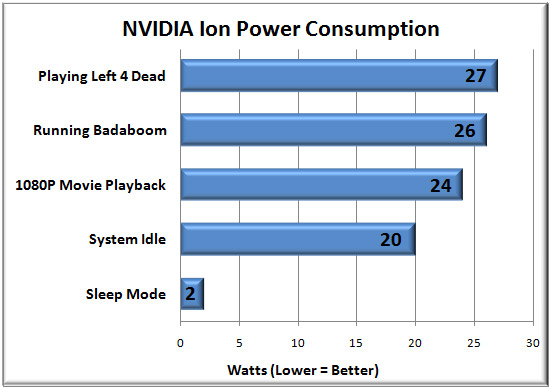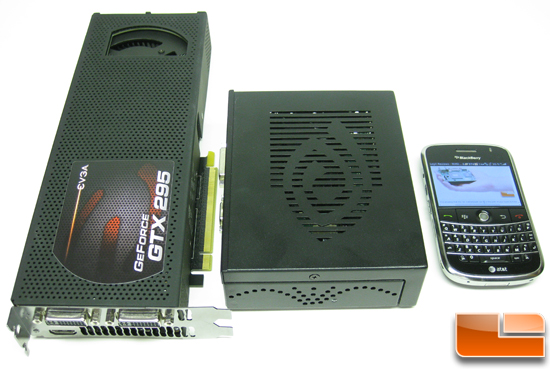NVIDIA Ion – Intel Atom Done Right?
Power Consumption and Conclusions
Power Consumption Results
Since power consumption is a big deal these days, we ran some simple power consumption tests on the NVIDIA Ion reference PC to see how much power this little PC consumes.

Results: The NVIDIA ION reference PC has awesome power consumption numbers as you can see from the chart above. The system consumes just 20 Watts while sitting at idle on the desktop, and when it is in sleep mode it consumes just 2 Watts. When playing a full HD movie at 1920x1080P the system power consumption jumped up to 24 Watts, so only a 4-Watt increase was observed for playing HD content. To transcode HD content using Badaboom, the power consumption jumped up to 26 Watts and the CPU was under more of a load. The highest observed Wattage was found while playing Left 4 Dead, which makes sense as it puts both the GPU and CPU under full load. With the NVIDIA Ion reference PC using less than 30W it is very energy efficient and green friendly.

Final Thoughts and Conclusions
The NVIDIA Ion can do so much it is hard to come to a conclusion on this platform. Without a doubt the NVIDIA Ion platform is going to turn heads when it comes to market as it is a mixture of a netbook, a laptop, and a desktop all in a miniature PC. Since the Ion has the ability to play HD content it would make a great platform to design an ultra sleek and lower power home theater PC (HTPC) or media PC. Could you imagine if a computer manufacturer picked up the Ion platform and put it in a slightly larger chassis that contained a slot load Blu-Ray player and a TV tuner? That would be the ultimate HTPC and I, for one, would purchase a pair to replace the two HTPC’s that I own. My most power efficient HTPC idles at 90W, so to move to something that takes up less space and 77% less power is an easy call.
When it came to 1080P HD playback the NVIDIA Ion had no problems at all and I even tested it on both the Samsung 2233RZ 120Hz Gaming LCD monitor with a DVI input and a pair of 42″ and 52″ 1080P HDTVs with the HDMI input. I even tried out the 7.1 audio on my receiver and found it to work great in my home theater, so the Ion is more than ready to serve as a media player. Playing games like Spore and Call of Duty 4 worked great when played with low image quality settings at 1024×768, but other games like World in Conflict and Left 4 Dead pushed the system a little too much. It should be noted that the NVIDIA Ion wasn’t designed to be a gaming system, so the fact that it can play a current DirectX 10 game title and render it correctly is impressive.
My user experience with the NVIDIA Ion was a good one for the most part. It does have a few little quirks here and there, but far less than most reference systems that I have gotten over the years. My biggest complaint was that when the system was put into sleep mode that it would lose the USB mouse when the system resumed operation. That was a little annoying, but something a BIOS update should be able to take care of. Another thing that I found to be odd is that I could install the game STALKER Clear Sky, but the system wouldn’t launch the game as the original disc wasn’t in the drive. The thing that was frustrating is that the original disc that I purchased from Best Buy for $49.99 was in the USB 2.0 optical drive and the system wasn’t registering that for some reason. Other than the couple of USB 2.0 complaints, my final gripe was on the system memory as the number of hard faults was a little high for my taste. A hard fault is not a memory error, but a way to monitor when the CPU is accessing something that is no longer in the cache or the page file. A 4GB DDR3 SO-DIMM would fix this, but none are available on the market today.
The NVIDIA Ion reference PC won’t be coming to market as you see it here today, but I have been told by NVIDIA that other companies will be bringing out versions of it for desktop and netbook use in the very near future. NVIDIA told me to expect ION-based desktop systems to be available for as low as $299 and that netbooks will cost a bit more, but $400 is a reasonable price point for a mini-note. They also made it clear that the price will increase with screen size, so it looks like $400 is where they expect netbooks to start. I just hope someone comes out with a PC like this with a Blu-Ray drive and a TV tuner as it would own in the consumer market if the price was right.
Legit Bottom Line: The NVIDIA Ion Reference PC is something to keep an eye on as it is sleek, sexy, and powerful enough to play 1080P content and even some games.

Comments are closed.